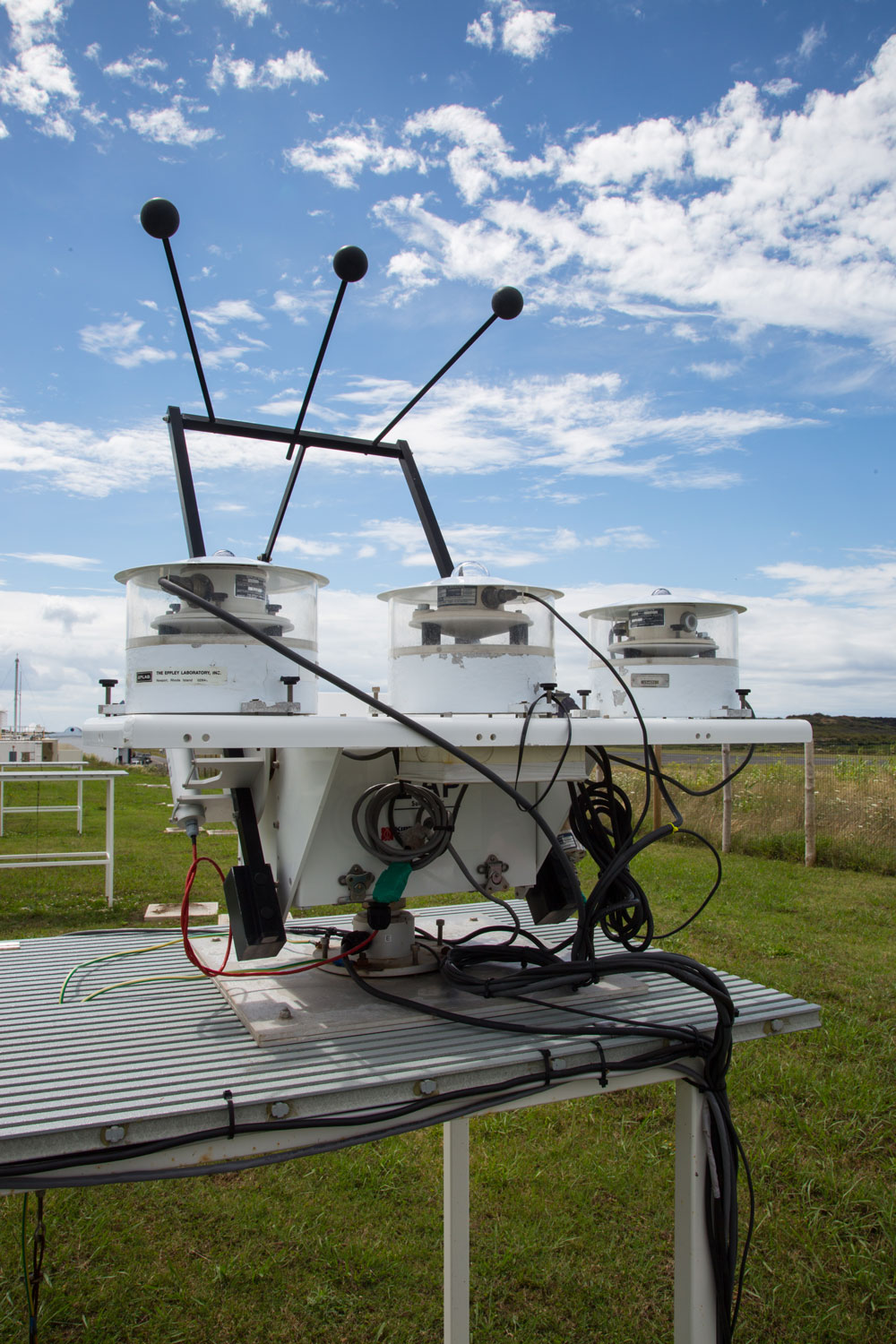New Broadband Irradiance Data Released for ARM Observatories
Published: 8 January 2022

The Atmospheric Radiation Measurement (ARM) user facility processes yearly data from the Data Quality Assessment for ARM Radiation Data (QCRAD) and Radiative Flux Analysis (RADFLUXANAL) products to produce level 2 (c2) data. New c2-level data from QCRAD and RADFLUXANAL are now available for ARM’s three fixed-location observatories. The 2019–2020 processing is complete, in addition to some 2020–2021 data.
QCRAD has long been the recommended ARM datastream for broadband surface irradiance measurements. QCRAD applies multiple data quality checks, applies a correction for errors due to infrared loss in shortwave radiometric measurements, and calculates a best-estimate total downwelling shortwave irradiance value.
RADFLUXANAL uses QCRAD as input and calculates clear-sky irradiance in the shortwave and longwave surface fluxes from broadband irradiance measured at ARM sites. RADFLUXANAL also calculates fractional sky cover and cloud parameters, including effective visible cloud optical depth, cloud radiating temperature, and shortwave cloud transmissivity, from the measurements.
When c2 files are available, they should be used instead of c1 data. For QCRAD, c2-level data include improved data for infrared loss correction.
At each site, the start and end dates of available data may differ between RADFLUXANAL and QCRAD. RADFLUXANAL requires clear days on which to start and end its processing, whereas QCRAD has no such requirements.
The sites and date ranges of the new c2-level data are as follows:
| Site | RADFLUXANAL date range(s) | QCRAD date range(s) |
|---|---|---|
| Eastern North Atlantic observatory (Graciosa Island, Azores) |
October 17, 2019–August 20, 2021 | October 18, 2019–August 20, 2021 |
| North Slope of Alaska observatory (Utqiaġvik/Barrow, Alaska) |
July 12, 2019–July 3, 2021 | August 30, 2019–July 15, 2021 |
| Southern Great Plains (SGP) Central Facility (Lamont, Oklahoma) |
August 28, 2019–May 22, 2020 | August 30, 2019–May 25, 2020 |
| SGP Central Facility broadband radiometer station (BRS) (Lamont, Oklahoma) | July 31, 2019–May 22, 2020 (RADFLUXANAL BRS processing requires data from QCRAD BRS and QCRAD) |
August 8, 2019–August 4, 2020 |
| SGP extended facility E9 (Ashton, Kansas) | August 20, 2019–July 2, 2021 | August 26, 2019–July 9, 2021 |
| SGP E11 (Byron, Oklahoma) | July 31, 2019–June 7, 2020 | August 2, 2019–June 9, 2020 |
| SGP E12 (Pawhuska, Oklahoma) | August 20, 2019–June 6, 2020 | August 26, 2019–June 9, 2020 |
| SGP E13 (Lamont, Oklahoma) | August 20, 2019–June 2, 2020 | August 28, 2019–June 4, 2020 |
| SGP E15 (Ringwood, Oklahoma) | August 19, 2019–July 11, 2021 | August 21, 2019–July 12, 2021 |
| SGP E31 (Anthony, Kansas) | July 25, 2019–June 7, 2020 | July 30, 2019–June 8, 2020 |
| SGP E32 (Medford, Oklahoma) *These 2016–2017 data were not previously available because of a gap in the SGP E32 input data. |
June 10, 2019–July 2, 2021, AND December 18, 2016–August 17, 2017* | June 14, 2019–July 9, 2021, AND December 18, 2016–July 28, 2017* |
| SGP E33 (Newkirk, Oklahoma) | June 10, 2019–June 10, 2020 | June 19, 2019–June 11, 2020 |
| SGP E34 (Maple City, Kansas) | July 20, 2019–June 17, 2020 | July 24, 2019–June 23, 2020 |
| SGP E35 (Tryon, Oklahoma) | June 24, 2019–June 24, 2020 | June 25, 2019–June 30, 2020 |
| SGP E36 (Marshall, Oklahoma) | June 24, 2019–June 25, 2020 | June 26, 2019–July 1, 2020 |
| SGP E37 (Waukomis, Oklahoma) | June 20, 2019–June 30, 2020 | June 22, 2019–July 2, 2020 |
| SGP E38 (Omega, Oklahoma) | July 24, 2019–June 24, 2020 | July 27, 2019–June 29, 2020 |
| SGP E39 (Morrison, Oklahoma) | September 4, 2019–June 24, 2020 | September 5, 2019–June 29, 2020 |
| SGP E40 (Pawnee, Oklahoma) | July 23, 2019–June 24, 2020 | July 24, 2019–July 2, 2020 |
| SGP E41 (Peckham, Oklahoma) | May 31, 2019–July 30, 2021 | June 19, 2019–August 4, 2021 |
In addition, QCRAD c2-level data from the Best-Estimate Radiative Flux (BEFLUX) value-added product are now available for the SGP Central Facility from August 30, 2019, to May 25, 2020. The QCRAD BEFLUX product takes the best estimate of irradiance measurements from the SGP Central Facility, BRS, and E13 radiometers.
Scientists can use the new data now. More information is available on the QCRAD and RADFLUXANAL web pages. To share your experience—such as how you use the data and how well they work for you—or to ask a question, contact ARM translator Damao Zhang.
Access the new QCRAD and RADFLUXANAL data in the ARM Data Center. (Go here to request an account to download the data.)
To cite the QCRAD BEFLUX data, please use doi:10.5439/1227218. For the QCRAD BRS data, please use doi:10.5439/1227217. For the other QCRAD data, please use doi:10.5439/1227214.
To cite the RADFLUXANAL BRS data, please use doi:10.5439/1395069. For the other RADFLUXANAL data, please use doi:10.5439/1395157.
Keep up with the Atmospheric Observer
Updates on ARM news, events, and opportunities delivered to your inbox
ARM User Profile
ARM welcomes users from all institutions and nations. A free ARM user account is needed to access ARM data.


















